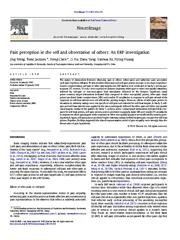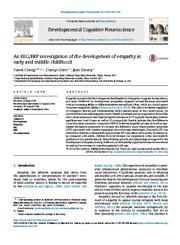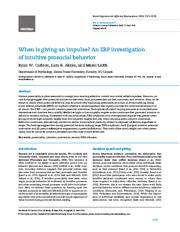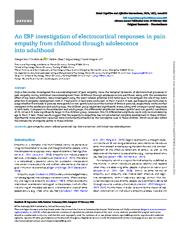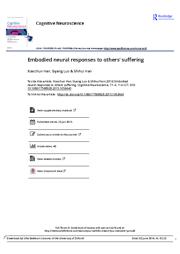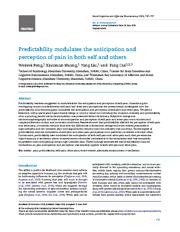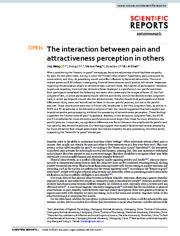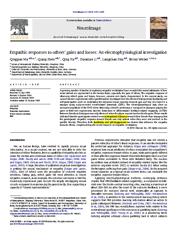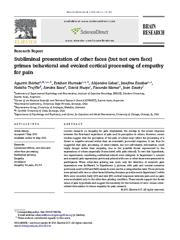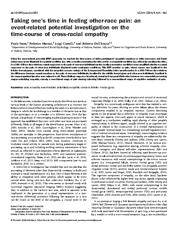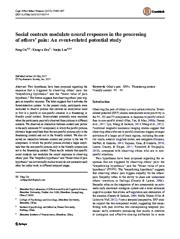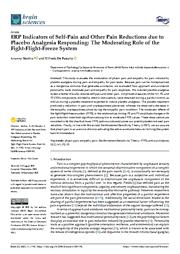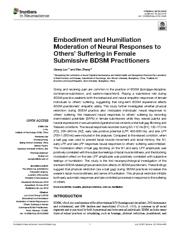A copy of this work was available on the public web and has been preserved in the Wayback Machine. The capture dates from 2017; you can also visit the original URL.
The file type is application/pdf.
Filters
Pain perception in the self and observation of others: An ERP investigation
2013
NeuroImage
a r t i c l e i n f o Keywords: Pain Empathy for pain Shared representation Threat value of pain Event-related potential (ERP) Congruency effects The nature of interactions between observing pain in others ...
(other-pain) and subjective pain perception (self-pain) has been debated. ...
Acknowledgments We thank two anonymous reviewers for their helpful contributions to the paper. ...
doi:10.1016/j.neuroimage.2013.01.024
pmid:23376492
fatcat:qy652wtp2bcvlijdheip7snp3q
An EEG/ERP investigation of the development of empathy in early and middle childhood
2014
Developmental Cognitive Neuroscience
As development progresses, empathic arousal becomes associated with an increasing ability to differentiate between self and other, which is a critical aspect of mature empathetic ability (Decety and Jackson ...
Only early LPP was detected in children, whereas both early and late LPP were observed in adults. ...
To investigate the developmental trajectories of empathic response to the pain of others during from early to middle childhood, we modified an EEG/ERP paradigm commonly used with adults for children aged ...
doi:10.1016/j.dcn.2014.08.012
pmid:25261920
pmcid:PMC6987874
fatcat:ogta5rp6gnhxvc5jgyrlqiwt3y
When is giving an impulse? An ERP investigation of intuitive prosocial behavior
2015
Social Cognitive and Affective Neuroscience
Using event-related potentials (ERPs), we explored whether a neural signature that rapidly encodes the motivational salience of an event-the P300-can predict intuitive prosocial motivation. ...
This work offers novel insight into when prosociality may be driven by intuitive processes and the roots of such behaviors. ...
For instance, autonomic changes (e.g. skin conductance responses) can be an equally useful predictor of our willingness to help when observing an individual in pain (Hein et al., 2011) . ...
doi:10.1093/scan/nsv077
pmid:26084530
pmcid:PMC4927032
fatcat:jc5gf5frdzhutenpbnv4ituibu
An ERP investigation of electrocortical responses in pain empathy from childhood through adolescence into adulthood
2024
Social Cognitive and Affective Neuroscience
Only a few studies investigated the neurodevelopment of pain empathy. ...
In the A-P and A-N task, participants are instructed to judge whether the models in pictures were painful or non-painful and count the number of limbs in pictures, respectively. ...
An examination of the collective findings from ERP investigations on pain empathy has indicated that the posterior P3 and LPC display discernment in response to the observation of pain in others (Coll ...
doi:10.1093/scan/nsae020
pmid:38483508
pmcid:PMC10939050
fatcat:vtzi7fzihzcf5mzlogsgnxslga
Dispositional Self-Construal Modulates the Empathy for Others' Pain: An ERP Study
2020
Frontiers in Psychology
The present study aimed to investigate neural correlates that underlie the modulation effect of dispositional self-construal on perception of others' pain. ...
The ERP results showed painful stimuli elicited decreased N2 amplitudes and larger P3 amplitudes than those by no-painful stimuli. ...
All authors contributed to the article and approved the submitted version. ...
doi:10.3389/fpsyg.2020.508141
pmid:33123035
pmcid:PMC7573162
fatcat:auy27e35cvegnhh4zqqi4yzrrm
Embodied neural responses to others' suffering
2015
Cognitive Neuroscience
Eventrelated potential (ERP) studies have shown that the perception of painful compared with non-painful stimuli applied to others modulates the amplitudes of early frontocentral (the frontal N1 and P2 ...
whether and how facial mimicry in observers affects their empathic neural responses to others' pain expressions, we recorded event-related potentials (ERPs) from Chinese adults while viewing pain and ...
doi:10.1080/17588928.2015.1053440
pmid:26111085
fatcat:wihk2wrtojdnriiysqijzpvn7a
Predictability modulates the anticipation and perception of pain in both self and others
2019
Social Cognitive and Affective Neuroscience
Considering the overlapping neural circuits between self-pain and other-pain perceptions, the present study investigated how the predictability of forthcoming pain modulates the anticipation and perception ...
Results showed that predictability affected the perception of self-pain and other-pain in a similar manner such that the differences in behavioral ratings and event-related potentials to high-intensity ...
This study was funded by the National Natural Science Foundation of China (no. 31871127 to W.P. and 31871109 to F.C.), Shenzhen Basic Research Project (JCYJ20170818093231953 to W.P.) and Shenzhen University ...
doi:10.1093/scan/nsz047
pmid:31236566
pmcid:PMC6778834
fatcat:f2dama3lobaixcf775nkxhnmm4
The interaction between pain and attractiveness perception in others
2020
Scientific Reports
The event-related potential (ERP) allows investigating if one of these theories could predict individuals' responses regarding the perception of pain or attractiveness in others' faces. ...
These results were observed in P3 and LPC amplitudes in the Pain Judgment Task, as well as in N170 and P2 amplitudes in the Attractive Judgment Task. ...
Acknowledgements We thank Yuanyan Hu for her assistance in permission to use, revise, and publish the image database. ...
doi:10.1038/s41598-020-62478-x
pmid:32218469
pmcid:PMC7099075
fatcat:usanvnpzgfcxtfirsq5zfifl2u
Empathic responses to others' gains and losses: An electrophysiological investigation
2011
NeuroImage
A growing number of studies in exploring empathic modulation have revealed the neural substrates of how social stimuli are represented in the human brain, especially the pain of others. ...
In the current study, we carried out two experiments with a gamble task to investigate how the effects of interpersonal familiarity and self-participation work on modulating the temporal neural response ...
Acknowledgments This work was supported by grant No.70772048, 90924304 from the National Natural Science Foundation, No.09JZD0006 from the State Education Ministry of China as a key project and No.09CG-GL008YBB ...
doi:10.1016/j.neuroimage.2010.10.045
pmid:20974264
fatcat:v27h2jupunhbngthyznecenkha
Subliminal presentation of other faces (but not own face) primes behavioral and evoked cortical processing of empathy for pain
2011
Brain Research
Current research on empathy for pain emphasizes the overlap in the neural response between the first-hand experience of pain and its perception in others. ...
However, recent studies suggest that the perception of the pain of others may reflect the processing of a threat or negative arousal rather than an automatic pro-social response. ...
Acknowledgments The study was partially supported by grants of CONICET, FINECO and University Diego Portales (CG090326010). The authors have no conflicts of interest related to this article. ...
doi:10.1016/j.brainres.2011.05.014
pmid:21624566
fatcat:locjwojaffgilmrdnz7r6qae6i
Taking one's time in feeling other-race pain: an event-related potential investigation on the time-course of cross-racial empathy
2013
Social Cognitive and Affective Neuroscience
Using the event-related potential (ERP) approach, we tracked the time-course of white participants empathic reactions to white (own-race) and black (other-race) faces displayed in a painful condition ( ...
In a 400-750 ms time-window, the difference between neural reactions to the pain of own-race individuals, localized in the middle frontal gyrus and other-race individuals, localized in the temporoparietal ...
To note, ERP studies investigating the perception of others' pain have reported different estimates of the time at which ERPs start to differentiate between painful and nonpainful conditions, ranging from ...
doi:10.1093/scan/nst003
pmid:23314008
pmcid:PMC3989124
fatcat:gdafiavmmzezhneua35anug3km
Social contexts modulate neural responses in the processing of others' pain: An event-related potential study
2017
Cognitive, Affective, & Behavioral Neuroscience
Two hypotheses have been proposed regarding the response that is triggered by observing others' pain: the Bempathizing hypothesis^and the Bthreat value of pain hypothesis. ...
The Bempathic hypothesis^and Bthreat value of pain hypothesis^are not mutually exclusive and do not contradict each other but rather work in different temporal stages. ...
Acknowledgements This study was funded by the National Natural Science Foundation of China, no. 31500877 and 31300846. ...
doi:10.3758/s13415-017-0517-9
pmid:28550624
fatcat:reuqcqtvcncmhobajpmpeg6qna
Neural mechanisms of modulations of empathy and altruism by beliefs of others' pain
2021
eLife
Moreover, lack of beliefs of others' pain attenuates neural responses to their pain expressions within 200 ms after face onset and modulates neural responses to others' pain in the insular, post-central ...
This perception-emotion-behavior reactivity is the core of human altruism but does not always occur in real life situations. ...
Acknowledgements Zhou for proofreading the manuscript. The funder had no role in the conceptualization, design, data collection, analysis, decision to publish or preparation of the manuscript. ...
doi:10.7554/elife.66043
pmid:34369378
pmcid:PMC8373377
fatcat:3khtey2vungyvkn6ggluumkmwq
ERP Indicators of Self-Pain and Other Pain Reductions due to Placebo Analgesia Responding: The Moderating Role of the Fight-Flight-Freeze System
2021
Brain Sciences
We induced placebo analgesia to test whether this also reduces self-pain and other pain. ...
The placebo treatment produced a reduction in pain and unpleasantness perceived, whereas we observed a decrease in the empathy unpleasantness alone during the empathy pain condition. ...
emotionally affective stimulation [117] , and the observation of others in pain [50, 118] . ...
doi:10.3390/brainsci11091192
pmid:34573212
fatcat:nl7axevi3rartenjhrtkcxtami
Embodiment and Humiliation Moderation of Neural Responses to Others' Suffering in Female Submissive BDSM Practitioners
2018
Frontiers in Neuroscience
Giving and receiving pain are common in the practice of BDSM (bondage-discipline, dominance-submission, and sadism-masochism). ...
We measured neural responses to others' suffering by recording event-related potentials (ERPs) in female submissives while they viewed painful and neutral expressions in sexual sadistic/general social ...
2017A030310553), the Science Foundation of Ministry of Education of China (Project 17YJCZH121), and the Guangdong Educational, Scientific, Cultural, and Health Industry Workers' Trade Union (Project 2018jkwwgh009 ...
doi:10.3389/fnins.2018.00463
pmid:30038558
pmcid:PMC6046371
fatcat:6lhbz5hhljh3thag22gwyn5ima
« Previous
Showing results 1 — 15 out of 3,008 results

